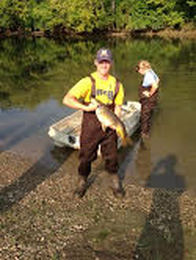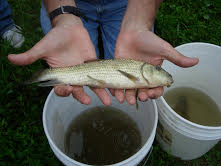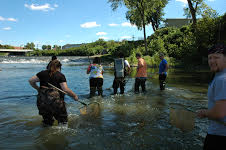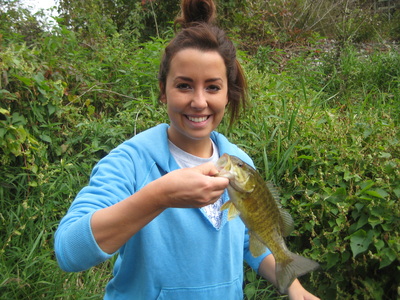You might not expect someone majoring in accounting to venture out into muddy waters chasing frogs. But, last year, the biology department gave me the chance to do just that.
by Zach Richardville
 Richardville poses with a carp he caught using a larger, buoyant electrofishing unit (shown in the background).
Richardville poses with a carp he caught using a larger, buoyant electrofishing unit (shown in the background). A snap of a branch somewhere underneath my foot is my only warning before suddenly my footing is helplessly lost. I stumble to my right for a step and a half before tripping over another submerged branch. As I fall, I flail my arms toward a nearby tree trunk in a last ditch effort to catch myself and successfully find support. I reposition my feet underwater to stand on what feels like even ground and survey the damage. My headlamp illuminates my waders, which are soaked up to the top, but no further. I consider myself lucky not to have taken a bath in the cold, swampy water, but the real problem is that my clamoring seems to have spooked the nearby frogs, which have fallen silent.
In spite of my overwhelming display of nimbleness and resultant spooking of the critters, I could not help but smile at how much fun I was having in class.
So how does an accounting major find himself doing something as enthralling as chasing frogs, salamanders and snakes in a swamp after dark – as part of a class? A minor in Biology allows me to take electives within the Department of Biology after finishing earlier required courses. These 400-level electives include choices such as Herpetology (the study of reptiles and amphibians), Ichthyology (the study of fishes), and Ornithology (the study of birds) among others. Each of these courses includes a corequisite lab portion during which students look at preserved specimens of the animals they are studying or actually traverse into the field and collect live specimens. Students are typically responsible for being able to identify Indiana species of the animals by their common and scientific names, so observing the animals in the field is instrumental in becoming familiar with the animals.
During the spring 2013 semester, I had the pleasure of being enrolled in Herpetology, which is taught by Dr. Kamal Islam, a passionate wildlife expert. The lecture portion of the course met twice a week, during which we discussed an array of topics ranging from phylogeny to locomotion and thermoregulation in amphibians. The lecture also included segments of David Attenborough’s Planet Earth that illustrated the topics we covered in class, which was also a refreshing alternative to a note-taking lecture session. The lab portion of the class involved hands-on work with preserved specimens, which gave us a chance to actually see the features we talked about in lecture on the animals. The opportunity to handle the animals was invaluable to a visual learner like myself. During one lab period, we ventured to Summit Lake State Park to search for any amphibians or reptiles we could find. I was ecstatic to spend a day overturning logs and snatching salamanders rather than sitting in the lab looking at specimens. We had another opportunity on a beautiful spring evening to break out the headlamps and waders and head to “Salamander Swale” after dark. There we found an abundance of several species of salamanders and frogs, all of which are thoroughly active. It was during this trip that I was able to get down and dirty (and nearly soaked) as I stumbled through knee-deep water in the dark, following the calls of nearby frogs. Although I almost went for an involuntary swim, the experience of exploring the natural habitat of the animals we were studying was an incredible experience that would never be available in a typical classroom.
During the fall 2013 semester, I was enrolled in Ichthyology, which is taught by Dr. Tom Lauer and qualifies as the last elective for the completion of my Biology minor. The structure of Ichthyology is similar to that of Herpetology, with two lecture meetings and one lab meeting per week. The first two weeks of lab were spent dissecting a Yellow Perch to gain familiarity with the general anatomy of a fish. The next several lab meetings were spent in the field, visiting locations such as Buck Creek and the White River. We waded into the water with an electro-fishing unit and netted live fish for observation and identification. Dr. Lauer did not use the unit himself, but rather instructed on how to use it safely and encourage us to do so. At the end of each lab period, the class would converge and we would observe all of the fish we had collected to illustrate some of the defining characteristics by which we can identify the Indiana species. As a student whose favorite hobby is fishing, the chance to do it as part of a class is a dream come true.
As an accounting major, I see a lot of the same concepts in my different classes. For example, there are countless transactions or situations that can affect an earnings account, as well as a discouragingly abundant number of rules for how the transactions must be recorded. While I enjoy the study of accounting and the sense of fulfillment that comes when the debits equal the credits, a break from the monotony of multiple business classes throughout the week is welcome and refreshing. I will never forget Dr. Lauer’s reaction on the first day of Ichthyology when he found out that I was an accounting major, sitting in the middle of twenty-some other students who had Zoology-relevant majors. He placed his elbows on his desk and slowly lowered his face into his palms. Luckily, as a kid that grew up with a healthy obsession with wildlife and dreams of becoming the next Steve Irwin, I am not a typical accounting major. This is something I am passionate about, and the diverse curriculum at Ball State University allows me to exercise that passion - and earn credit for it. Because of the exhilarating experiences offered in my zoology courses, I find myself able to take a break from reconciling a bank account to spend a little time in the field reconciling my love for wildlife and the outdoors.
In spite of my overwhelming display of nimbleness and resultant spooking of the critters, I could not help but smile at how much fun I was having in class.
So how does an accounting major find himself doing something as enthralling as chasing frogs, salamanders and snakes in a swamp after dark – as part of a class? A minor in Biology allows me to take electives within the Department of Biology after finishing earlier required courses. These 400-level electives include choices such as Herpetology (the study of reptiles and amphibians), Ichthyology (the study of fishes), and Ornithology (the study of birds) among others. Each of these courses includes a corequisite lab portion during which students look at preserved specimens of the animals they are studying or actually traverse into the field and collect live specimens. Students are typically responsible for being able to identify Indiana species of the animals by their common and scientific names, so observing the animals in the field is instrumental in becoming familiar with the animals.
During the spring 2013 semester, I had the pleasure of being enrolled in Herpetology, which is taught by Dr. Kamal Islam, a passionate wildlife expert. The lecture portion of the course met twice a week, during which we discussed an array of topics ranging from phylogeny to locomotion and thermoregulation in amphibians. The lecture also included segments of David Attenborough’s Planet Earth that illustrated the topics we covered in class, which was also a refreshing alternative to a note-taking lecture session. The lab portion of the class involved hands-on work with preserved specimens, which gave us a chance to actually see the features we talked about in lecture on the animals. The opportunity to handle the animals was invaluable to a visual learner like myself. During one lab period, we ventured to Summit Lake State Park to search for any amphibians or reptiles we could find. I was ecstatic to spend a day overturning logs and snatching salamanders rather than sitting in the lab looking at specimens. We had another opportunity on a beautiful spring evening to break out the headlamps and waders and head to “Salamander Swale” after dark. There we found an abundance of several species of salamanders and frogs, all of which are thoroughly active. It was during this trip that I was able to get down and dirty (and nearly soaked) as I stumbled through knee-deep water in the dark, following the calls of nearby frogs. Although I almost went for an involuntary swim, the experience of exploring the natural habitat of the animals we were studying was an incredible experience that would never be available in a typical classroom.
During the fall 2013 semester, I was enrolled in Ichthyology, which is taught by Dr. Tom Lauer and qualifies as the last elective for the completion of my Biology minor. The structure of Ichthyology is similar to that of Herpetology, with two lecture meetings and one lab meeting per week. The first two weeks of lab were spent dissecting a Yellow Perch to gain familiarity with the general anatomy of a fish. The next several lab meetings were spent in the field, visiting locations such as Buck Creek and the White River. We waded into the water with an electro-fishing unit and netted live fish for observation and identification. Dr. Lauer did not use the unit himself, but rather instructed on how to use it safely and encourage us to do so. At the end of each lab period, the class would converge and we would observe all of the fish we had collected to illustrate some of the defining characteristics by which we can identify the Indiana species. As a student whose favorite hobby is fishing, the chance to do it as part of a class is a dream come true.
As an accounting major, I see a lot of the same concepts in my different classes. For example, there are countless transactions or situations that can affect an earnings account, as well as a discouragingly abundant number of rules for how the transactions must be recorded. While I enjoy the study of accounting and the sense of fulfillment that comes when the debits equal the credits, a break from the monotony of multiple business classes throughout the week is welcome and refreshing. I will never forget Dr. Lauer’s reaction on the first day of Ichthyology when he found out that I was an accounting major, sitting in the middle of twenty-some other students who had Zoology-relevant majors. He placed his elbows on his desk and slowly lowered his face into his palms. Luckily, as a kid that grew up with a healthy obsession with wildlife and dreams of becoming the next Steve Irwin, I am not a typical accounting major. This is something I am passionate about, and the diverse curriculum at Ball State University allows me to exercise that passion - and earn credit for it. Because of the exhilarating experiences offered in my zoology courses, I find myself able to take a break from reconciling a bank account to spend a little time in the field reconciling my love for wildlife and the outdoors.




